Before 20th Century
97 Products
-
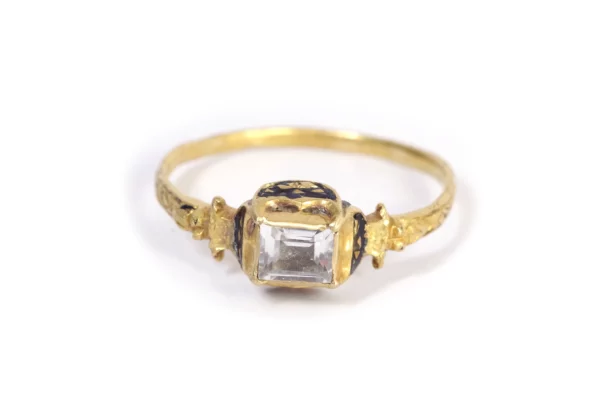
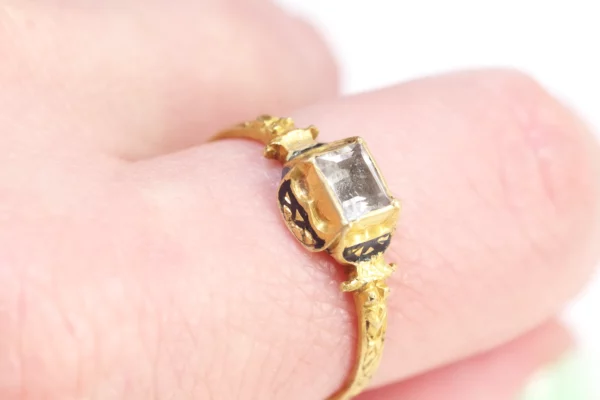 Out of Stock
1,00€
Out of Stock
1,00€Scarce rock crystal Renaissance ring in 22 Karat gold. This 16th-century ring is setted with a table-cut rock crystal in a closed setting. The bezel is decorated with black enamel with gold highlights and double crescent motifs, ending in four prongs. The shoulders feature fine chiseling. Renaissance ring from the 16th century, Western Europe. During the Renaissance, rings evolved from the simple forms of the medieval period to miniature works of art, combining the skills of the chiseler, engraver, enameler, and stone cutter. Cabochon settings persisted, but the evolution of stone cutting allowed for the increased use of table cuts.
Ring size: 57 EU or 8 US
Bezel dimensions: 7 x 8 mm
Estimated weight of the rock crystal: 0.49 ct
Note: For examples of similar 16th-century rings, see items 334 and 430 in Scarisbrick’s “Rings; Jewellery of Power, Love and Loyalty” (2007); item AF.1743 in the British Museum collection and items 279 and 281 in the “Victoria and Albert Museum Catalogue of Rings” by Oman (1930).
Condition: normal wear consistent with age, a missing part in the setting.
Weight: 2.91 gr
-
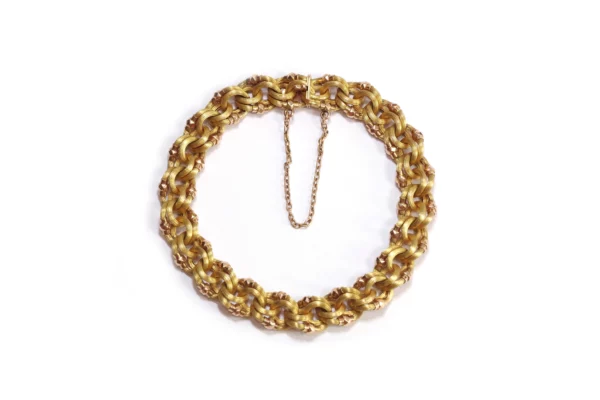
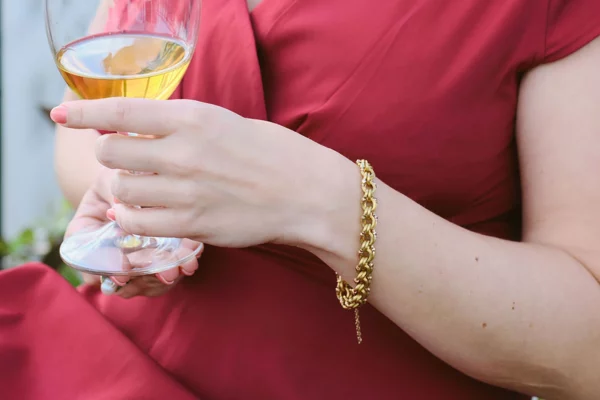 2000,00€
2000,00€Antique Antillean bracelet in 18k yellow gold. Antique bracelet composed of twisted links forming grooved rings decorated with faceted spherical motifs. Antique bracelet from the Antilles, circa 1880, France.
Hallmarks: eagle’s head, rhinoceros head, and maker’s mark.
Length: 19.5 cm
Width: 10 mmNote: the clasp is secured by an 18 karat gold safety chain.
Condition: minor wear and tearWeight : 17.71 gr
*The antique box is not sold with the jewel*
Further information : Traditional jewelry is still worn in the Antilles for special occasions and cultural events. This regional Antilles jewelry is characterized by elaborate motifs such as twisted gold wires, vine leaves, forçat mesh, fluting, “gros sirop” mesh, gold wire spirals, etc.
-

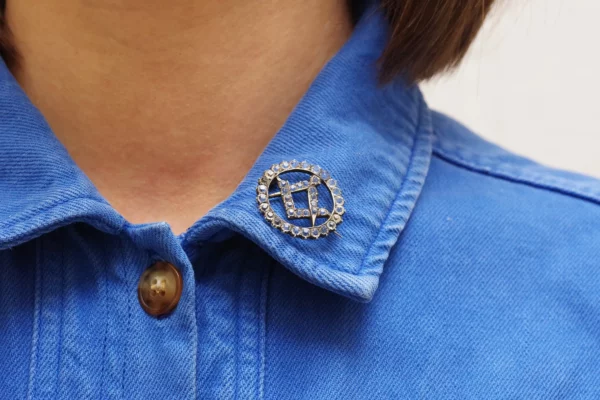 450,00€
450,00€Antique Masonic brooch in silver. Masonic brooch featuring the Square and Compasses within a circle, set with rhinestones. The combination of the Square and Compasses forms a square within the circle, symbolizing matter surrounded by the spiritual. The reunion of body and spirit can be supported by the quest for the squaring of the circle. In Masonic believes, the Compass symbolizes spiritual measurement and the individual’s ability to keep their actions within the bounds of what is right and appropriate. It also represents the capacity for self-assessment and improvement. The Square, on the other hand, represents the virtue of living a straight and balanced life, while respecting moral and ethical laws. Antique brooch, circa 1900.
Swan hallmark (french state hallmark for silver)
Diameter: 26 mm
Condition: signs of wear
Weight: 3.76 gr
*The antique gold chain is not sold with the jewel*
-
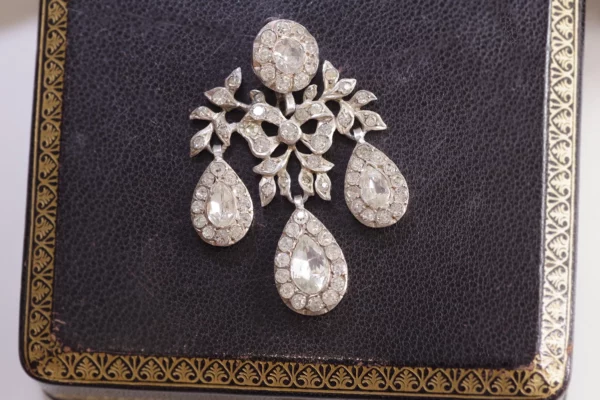
 700,00€
700,00€Victorian silver girandole pendant in silver 800. A girandole pendant forming a large knot holding three drops in the style of late 18th-century jewelry. The entire piece is set with white paste stones on foils. Victorian period, circa 1860-1880, France.
Boar hallmarks (french state hallmark for silver)
Height (with setting): 50 mm
Width: 33 mmCondition: fine wear scratches
Weight : 11.31 gr
*The antique box and the chain are not sold with the jewel*
See our antique chains -
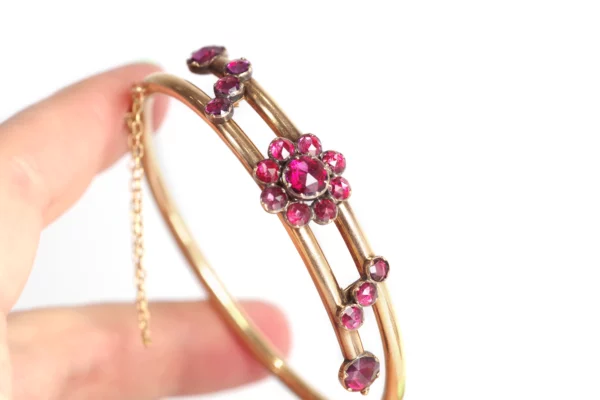
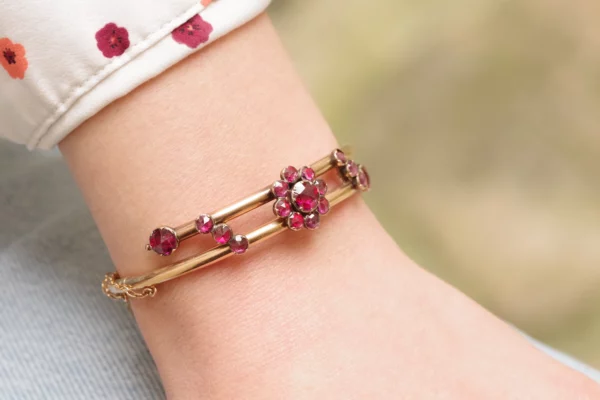 2600,00€
2600,00€Perpignan garnet bangle bracelet in 18 karat rose gold. Bangle bracelet featuring a rose gold hollow stem, the ends decorated with garnets. In the center of the bracelet, a flower formed of 9 round garnets, and on the sides a barrette motif formed of 3 garnets. The stones are “Perpignan” cut, a rose cut with a flat base. They have a beautiful raspberry-pink-red color, typical of Perpignan garnets. The garnets are mounted on foil and in closed setting. The setting is delicately decorated with triangular V-shaped figures on the edges, and the bezel backgrounds are domed. The clasp is a box-latch secured by a chain. Antique rush bracelet, circa 1880, Southeastern France.
Horsehead hallmarks (1838-1919, french state hallmark for 18 karat gold)
Center width: 14 mm
Inside length: 16.5 cm
Inside dimensions: 5 x 5.5 cmCondition: slight wear scratches, small dents behind two bezels, a inner crack in one of the garnets.
Weight : 9.96 gr
-
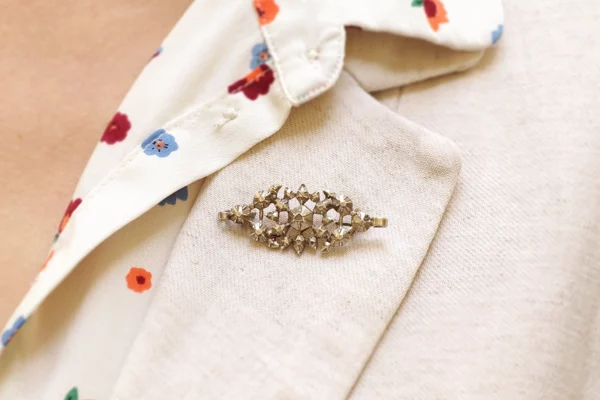
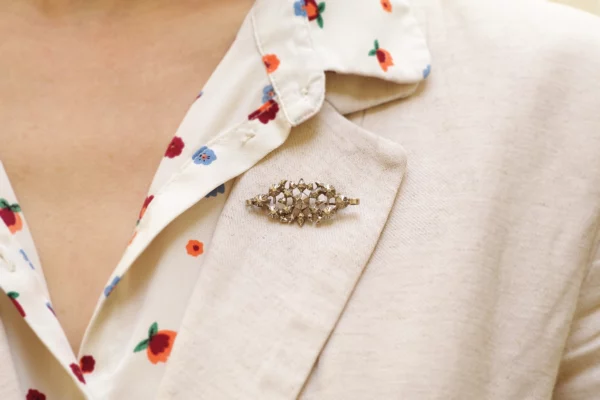 270,00€
270,00€Antique French silver diamond brooch from Arles. Antique regional brooch decorated with openwork motifs. The center of the brooch is adorned with a small diamond in a crumpled-effect setting, a motif typical of the South of France. The brooch is partially gilded on the reverse to prevent silver staining clothing. Antique regional brooch, France, late 19th century.
Height: 17 mm
Width: 4 cmCondition : scratches from use
Weight : 5.74 gr
-
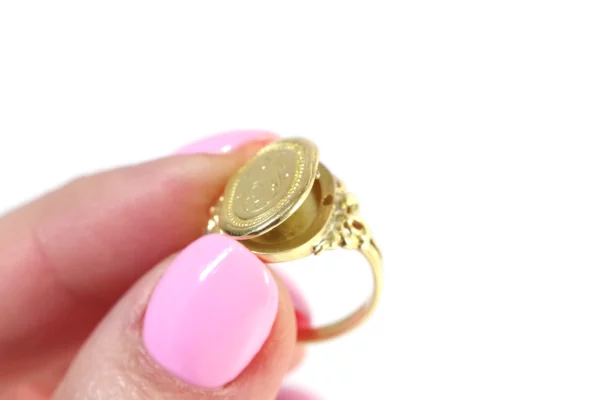
 1250,00€
1250,00€Gold signet secret ring in 18 karat gold. Opening secret ring, decorated on the plate with the letter J in calligraphy. The ring opens to reveal a secret compartment that can conceal a photo or souvenir. The shoulders of the ring are delicately decorated with a ribbon motif. Antique sentiment ring, late 19th century. Owl hallmarks (18k gold)
Finger size: 52 EU or 6 US (can be changed)
Tray dimensions: 13 x 11 mm
Inner cavity dimensions: 11 x 8 mm
Condition: slight wear scratches, compartment closes well
Weight : 3.76 gr
*The antique box is not sold with the jewel*
-
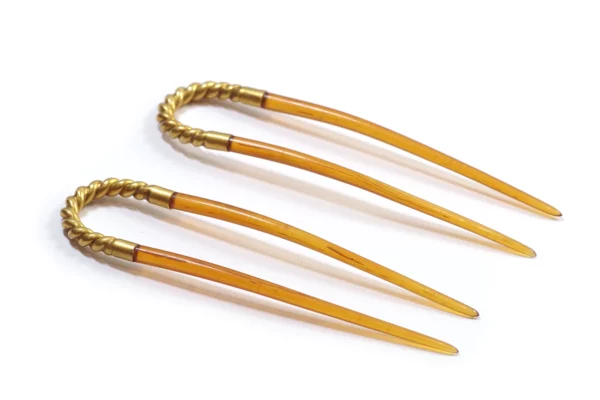
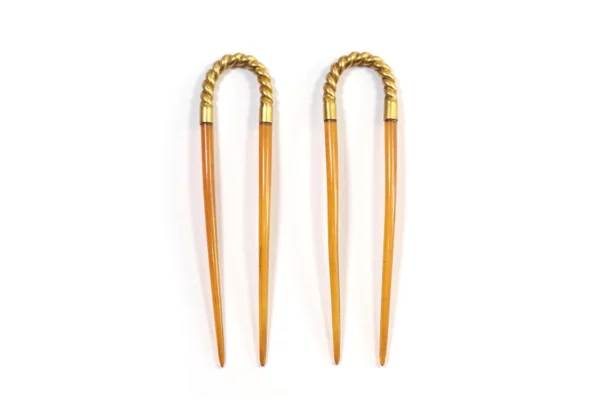 740,00€
740,00€Gold Victorian wedding hair pins. This pair of pins consists of two two-prong combs in blond organic material and a twisted-effect element in 18 karat gold. Sold as a pair. France, late 19th century.
True head jewels, these late 19th-century hair accessories will adorn and sublimate your wedding chignon and add a romantic finishing touch.
Eagle head and goldsmith hallmarks
Height: 9.5 cm Width: 2.1 cm
Condition: scratches from use
Weight: 3.96 gr each
Unit price : 340 €
A smaller pair of the same model is available to complete a set of 4 hairpins (last photo).
To view them, click here.Learn more about antique hairstyles: from the 19th to the 20th century, women styled their hair with tendrils (twists plastered on the forehead) and curls framing each side of the face. They added to their hairstyle a comb, flowers, leaves, or ribbons adorned with jewelry.
-
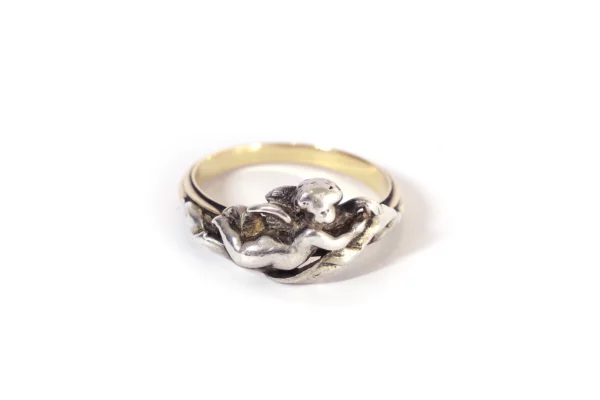
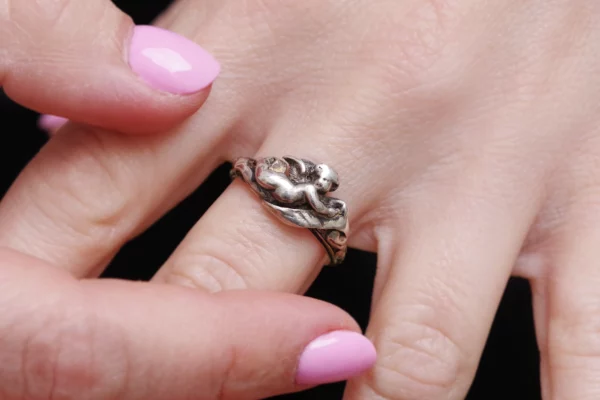 2900,00€
2900,00€Fannière Frères angel ring in 18 karat gold and silver 800. Antique ring with charming decoration, depicting an angel holding a ribbon. The angel is in silver, mounted on a gold ring soberly decorated with fine striations. The ring is signed on the inside. Ring made by the Frères Fannière, famous 19th-century silversmiths, circa 1870, France.
Fannières Frères signature, trace of eagle head, owl and swan hallmarks
Finger size: 55 UE or 6.75 US (can be changed)
Angel size: 10 x 16 mm
Condition: light usual scratches, patinated silver
Weight: 4.68 g
More information : The company was founded in 1839 by François-Auguste Fannière (1818-1900) and François-Joseph-Louis Fannière (1820-1897), nephews and students of goldsmith Fauconnier. At once designers, sculptors, chiselers and manufacturers, they worked for leading Paris silversmiths such as Baugrand, Duron, Wiese, Odiot, Froment-Meurice and Christofle, then under their own name from 1862. The company was taken over in 1900 by François-Joseph-Louis Fannière’s son, then by Fernand Poisson. Few pieces of jewelry have survived.
*The antique box is not sold with the jewel*
-
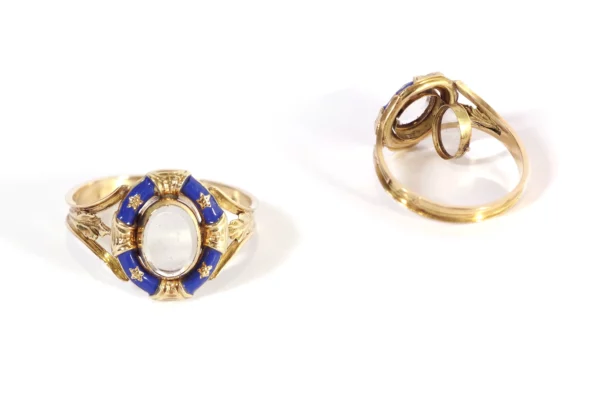
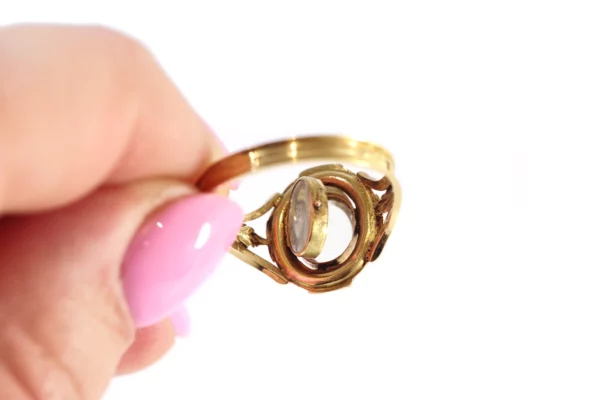 Out of Stock
1,00€
Out of Stock
1,00€Blue enamel secret locket ring in 18 karat yellow gold. Rare French Victorian ring with secret glass compartment, set in a blue enamel surround decorated with gold stars. The compartment opens from the inside of the ring to hold a photograph or other sentimental object. The shoulders are decorated with stylized leaves and chasing. Middle of the 19th Century, circa 1840, France.
Eagle head hallmark (French state hallmark for 18-karat gold) and partially legible goldsmith’s hallmark.
Finger circumference: 55 UE or 7.25 US (possible sizing)
Bezel size: 13 x 11 mm
Condition: slight wear scratches
Weight : 1.48 gr
*The antique box is not sold with the jewel*
-

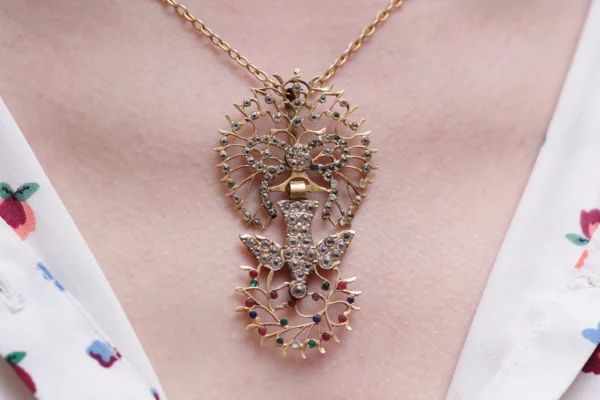 1500,00€
1500,00€Gold Normandy Saint Esprit pendant in 18 karat gold. Originally from Normandy, it features a dove with its head down, holding an olive branch in its beak. The bird hangs from a bow richly decorated with white paste stones, imitating diamonds. Red and green faceted glass adorns the olive branch at the bottom. A flat ring on the reverse of the pendant allows it to be worn on a velvet chain or ribbon. Norman regional catholic pendant, France, circa 1850.
Horse hallmark (1838-1919), regional trumpet hallmark and partially erased goldsmith’s hallmark.
Height: 6.5 cm
Width: 3.7 cmCondition: minor wear
Weight : 8.60 gr
*The antique box and the chain are not sold with the jewel*
See our antique chains -
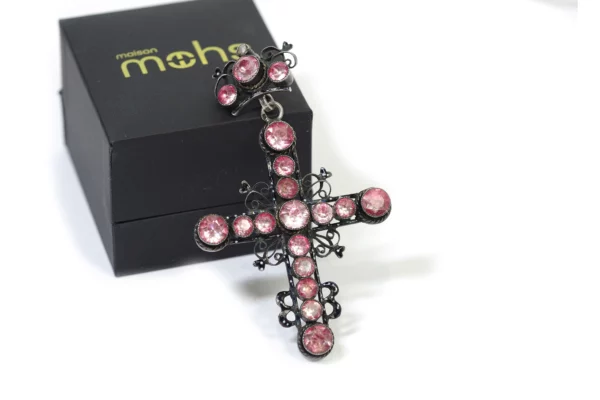
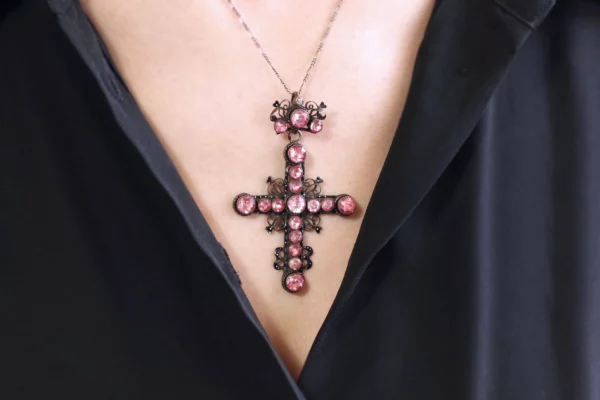 480,00€
480,00€Victorian French enamel foiled paste cross pendant in silver. This cross is in silver with filigree decoration, forming a cross adorn with paste faceted pink glasses on spangles meant to have a look of pink topaz. A black enamel decoration with white dots covers the entire pendant. A glass bead adorns the upper part of the composition. The bezels are completely closed. French work from the beginning of the 19th century
French work from the middle of the 19th century
Wild boar hallmark
Width: 4.3 cmCondition: lack of enamel, cracks.
Weight: 13.37 g
*The antique gold chain is not sold with the jewel*
See our antique chains
